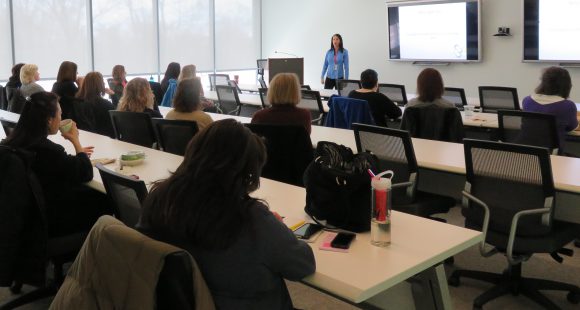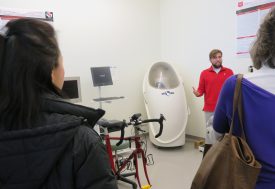
Michelle Arent presents “Why Diets Fails” to SEBS staff.
On January 20, Michelle Arent, director of training and conditioning at Rutgers Center for Health and Human Performance (CHHP) at the New Jersey Institute for Food, Nutrition, and Health (IFNH), gave a presentation to SEBS staff members on “Why Diets Fail.” The talk was an activity of the “SEBS Staff Scene,” which offers administrative staff the opportunity to expand their knowledge of the school community and campus and get to know other staff members through a variety of activities during lunch hour sessions.
Arent, who earned her M.P.H. from The University of South Carolina, has spent over 20 years in the health and fitness industry and works with clients across the age spectrum—from youth to octogenarian. Her outlook on health and fitness is that nutrition and exercise need to be viewed as tools for change and not used as a form of punishment. In her words, “Far too many people view exercise as a form of punishment and food as something they must battle. If we can learn how to put them to work FOR us then that is when the real magic happens.”
Arent explained that when people don’t reach their health and fitness goals after undertaking weight loss plan, after weight loss plan, it can cause them to give up all together. Her goal is to help people avoid this.
So why is it that so many diets fail?
- People are confronted with so much conflicting information that it is hard to navigate advertising and buzzwords and find the truth and science of the matter.
- Cutting calories, or “eat less, move more,” isn’t always the answer.
- People focus on minutia, and miss the big picture.
- Habits always beat intentions.
- Lack of sleep–less than six hours of quality sleep can blunt fat loss.
- People use exercise as a trade-off for food–it is NEVER just about the food.
- Muscle mass is important for “burning calories” but there is much more to it than that. Muscular contraction (exercise) can be the first line of defense/treatment for diseases such as diabetes.

David Sanders explains how the equipment in the Center for Health and Human Performance is used to assess athletic performance.
Arent emphasized that for any plan to succeed, it must positively impact how you look, function and feel. She added, “Just doing work does not automatically deliver the result you are after. You need to do work specifically designed to deliver the result you are looking for.”
Following the presentation, Arent gave a tour of the CHHP. Doctoral student David Sanders demonstrated some of the state-of-the-art equipment used in the center for measuring health and fitness.
In addition to giving key pointers on how to evaluate any diet in under 30 seconds, Arent also introduced the group to the Center’s Health and Fitness Program. The program has 3 key components: Intense Cardio Exercise (ICE) which is specifically designed for fat loss, Focused Intense Resistance Exercise (FIRE) which is designed to build muscle, and Healthy Lifestyle Class which focuses on behavior change around exercise and nutrition. Arent explained that a person’s goals, along with fitness testing, can aid in determining which class or classes are right for them. These sessions are open to everyone.

